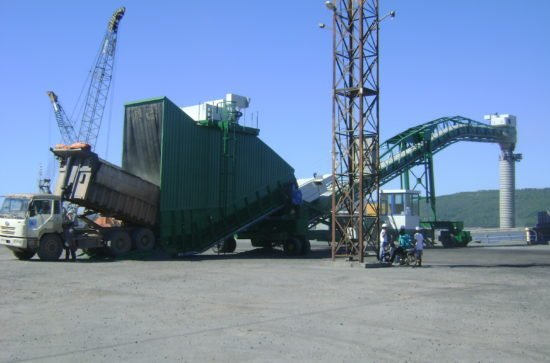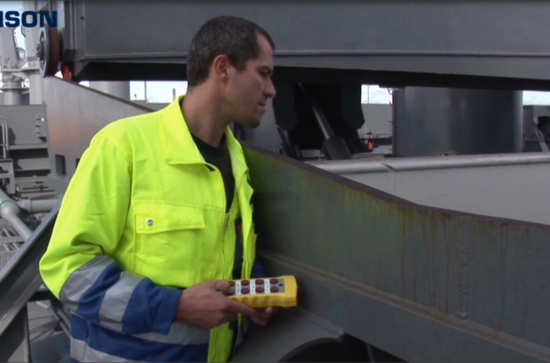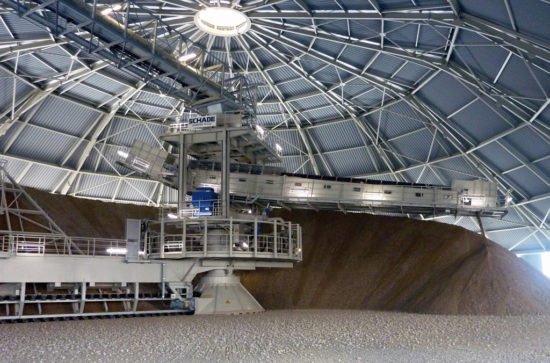Shiploading and Unloading of Bulk Materials used in the manufacture of Portland Cement
Jon Parker, Ely, UK, 1. January 2018
SAMSON Materials Handling
The AUMUND name is synonymous with the supply of high quality equipment to transport materials used in the manufacture of Portland Cement, so it’s little surprise to know that SAMSON Materials Handling Limited (a part of the AUMUND Group) are also highly experienced in providing material handling solutions from point of extraction to final reception at the grinding plant. SAMSON specialise in designing mobile equipment that deliver strong performance for the environmentally and respectful export and import of dry bulk materials.

Cement clinker is increasingly traded internationally in response to variations in supply and demand. Areas of surplus production can profit from the increased demands of regions that are investing heavily in infrastructure that may not have sufficient clinker production capacity. A lack of natural resources or unreliable supply networks can also drive shipping.
Cement production is an energy intensive process and contributor in the release of harmful atmospheric gases. It, therefore, makes sense to ensure that global capacity is fully utilized. Transportation systems must be carefully planned and designed to combat the problems associated with very fine and dusty materials which can create environmental problems if not transported correctly. Over recent years, concern for the environment and public health has led to the adoption of a range of environmental protection measures and the threat of punitive action for non- compliance. Companies within the Cement Industry are encouraged to take action. A range of shiploaders and ecological hoppers have been specifically developed by SAMSON Materials Handling for the conveying of cement production related materials which limit their environmental impact during loading and unloading operations. Careful design limits dust generation at source and measures to combat spillage are vital requirements of any solution. These features are also beneficial as they increase the percentage of deliverable product while also limiting material degradation.
Exporting Cement Clinker
Upon arrival at a port trucks laden with cement clinker can discharge quickly and safely using a SAMSON Material Feeder integrated with a Shiploader. The SAMSON Material Feeder can either be a single truck reception unit, or for greater capacity a double (or even quadruple) truck reception unit.
The buffer capacity of the SAMSON Material Feeder allows for continuous ship loading during truck manoeuvring. Handling rates of 1200 tph are to be expected for an integrated SAMSON Material Feeder and Shiploader solution.
As the SAMSON Material Feeder is fully integrated with the Shiploader, measures to avoid dust creation are already built-in at the most vulnerable point – namely the transfer point between the Material Feeder and the main Shiploader boom. Here careful design minimises the amount of dust created with dust filters and seals provided to make sure no product or dust escapes to the surrounding environment.

For very dusty materials the SAMSON Material Feeder can be provided with a profiled steel enclosure with an integrated reverse jet dust filter unit to keep the surrounding environment contamination free. Furthermore, the truck passes through a rubber curtained area before discharging the product. Depending on the application SAMSON enclosures can also be made from flexible PVC covers.
As the cement clinker travels along the Shiploader boom it is protected from cross winds by a canvas enclosure. When it reaches the ship it is discharged through a telescopic cascade trimming chute. Cascade trimming chutes control the material velocity from the outloading boom head to the hold floor by directing the clinker down a series of inclined cones this prevents excessive particulate separation and the creation of dust at source. There is also an external flexible cover enclosing the entire chute as a further dust prevention measure. Telescopic chutes are always preferable when trimming vessels with light dusty materials as they eliminate the effect of cross winds and the resulting cargo losses and risk of pollution.
The telescopic cascade trimming chute is the preferred option when trimming a vessel with cement clinker. Designed specifically for cement clinker this device limits the dust escape and material can be directed to the chosen area of the hold by the operator. Material can be easily placed in the hold by the operator from the vessel deck using radio or infrared remote control systems which allows for better use of space in the hold.
The SAMSON Material Feeder and Shiploader, whether integrated versions or free-standing, can be easily travelled along the quay to be used at different berths and stowed away when not in use.
Self-Powered machines allow for speedier repositioning for trimming and therefore a higher average loading rate. The configuration and alignment of the wheel bogies can provide in-line, parallel or radial travel functions to suit the layout of the port and the vessels to be loaded.
Importing Cement Clinker
Upon arriving at the port of destination the cement clinker can be unloaded from a geared vessel or via a shore-side crane into a SAMSON Eco Hopper. Unloading rates of up to 5000 tonnes per hour can be achieved depending on the grab crane’s performance.

The clinker is released from the grab and protected from the wind by a shroud surrounding the inlet grille. As the clinker is descends into the Eco Hopper, integral reverse jet filters situated around the top edge of the structure are activated and ensure that any escaped product is returned to the material flow.
Passing into the hopper the clinker travels through the Flex-Flap System. This is a series of rubber flaps attached to a steel grid. The weight of the product causes the flaps to yield allowing the clinker to enter the lower hopper. Displaced air rushes upwards and closes the flaps, preventing dusty air escaping to atmosphere.

The clinker is then discharged into waiting trucks via a dust controlled loading spout, or onto onward conveyors for storage or processing. Dependant on the configuration of the port and environmental procedures some SAMSON Eco Hoppers also provide loading enclosures for trucks to further minimise the escape of dust. Extraction fans are always located at transfer points (either at the truck loading chute or the discharge to ongoing conveyor).

SAMSON Eco Hoppers are designed to be mobile. They are mounted either on rails or wheels and can be deployed along the quay side as required.
The throughput of an import terminal can be greatly increased by the addition of Eco Hoppers however; port designers must ensure that the onward conveying system can accommodate the discharge rates. The long term benefit of the SAMSON Eco Hopper is that it can be designed for adaption to accommodate future infrastructure improvements.
Conclusions
Mobile handling equipment offers rapid set-up and operation at busy ports and terminals. SAMSON equipment provides a flexible and durable solution specifically suited to the material characteristics of cement related products. Mobile equipment allows importers and exporters to respond quickly to changes in markets; providing extra capacity and change of operational location with minimal disruption or harm to the environment.
Contact
If we can help you with any further information, please use the contact form to get in touch.
You will receive an immediate automated acknowledgement, and we will respond to your enquiry as soon as possible.
Many thanks
AUMUND. SCHADE. SAMSON.








